Install CAL Server (Legacy)
Product no longer available: From January 1, 2016, the stand-alone memoQ CAL server is not available for purchase. Existing customers continue to receive support. This topic contains instructions to reinstall or move your CAL server.
Cannot install new CAL server: You will not be able to install a new CAL server if you do not have a license already.
This topic is about the stand-alone memoQ CAL Server. The CAL Server distributes, translator, project manager, and web licenses of memoQ.
To use CAL licenses, you need a server that distributes concurrent-access licenses. This server is called a memoQ CAL server.
In most cases, a CAL server is a regular memoQ server. memoQ server can always distribute CAL licenses if it is configured that way (and has a license pool).
The - now outdated - stand-alone CAL Server does nothing but distribute CAL licenses. Before January 1, 2016, the stand-alone CAL server was a separate product from memoQ Zrt. Now the CAL server functionality is available in memoQ server only.
A memoQ cloud is also a CAL server – it will offer CAL licenses to memoQ clients that connect to it, for a much lower entry cost than that of a full memoQ server.
No need for CAL server to run memoQ on terminal servers: memoQ copies running on terminal servers can now receive licenses from memoQ servers, too. For this to work, you need memoQ 2015 (build 7.8.50 and higher). Earlier memoQ versions – when running on a terminal server – can receive CAL licenses from a stand-alone CAL server only.
A CAL server always knows how many licenses are in use, and who is using them. In addition, the CAL server is the one that allows users to run memoQ. The CAL server ensures that the number of translator pro, project manager, and web licenses in use never exceed the allowed limit – and the server monitors this in real time.
When a user starts memoQ, the CAL server takes away one license from the pool. When the same user closes memoQ, the server puts the license back in the license pool.
To make this work, memoQ contacts the CAL server once every 30 seconds, and notifies the server when it is closed. If the connection is lost, memoQ loses the license within 2 minutes, and the licensing server returns the license to the pool.
To use a CAL license, memoQ needs to remain connected to the CAL server; in many cases this means that memoQ needs to be connected to the Internet. As a result, you cannot use memoQ offline if your license comes from a CAL server.
Installing a CAL server requires more knowledge and experience than installing a desktop program such as memoQ itself.
Do not start making changes to your system unless you are completely aware of what you are doing.
As part of product support, memoQ Zrt. offers to help you install your CAL licensing server on your computer. We recommend that you stop making changes to your system immediately, and ask for our help:
- if any unclear points remain after carefully reading this document, or
- if your system behaves in an unexpected way when you start installing the CAL server.
Asking for help from memoQ Zrt.’s product support may save you a lot of time and frustration if you fail to install the CAL licensing server at the first attempt.
If your organization uses a memoQ server, do not install a stand-alone CAL licensing server. Instead, set up CAL licensing in memoQ server, using the CAL licenses category of Server Administrator.
To run a memoQ CAL server, your computer must meet the following requirements:
- A PC that can run Windows 8 or Windows 10, or more powerful. The computer must meet the minimum system requirements of Windows 10.
- 1 GB of RAM. A memoQ CAL server is a lightweight program: a smaller amount of memory may be enough, but going below the requirements of Windows is not recommended.
- 400 MB of hard disk space for the application (because it includes the memoQ server deployment package, which takes the majority of this space). Up to 50 megabytes might be required for data stored by the CAL server.
- A Windows operating system: Windows 7 or higher, or Windows Server 2008 or higher. 32-bit and 64-bit systems are both supported.
- Microsoft .NET Framework 4.0 or higher. Depending on your Windows version, you might need to install this prerequisite manually.
- TCP port 2705 open on the server and any firewalls. This is the main service port: the CAL server computer must be accessible through this port at all times.
No known conflicts: You can install the CAL server on any computer that meets the above requirements. It can be a terminal server, a domain controller, or a Web server. You can also use a desktop computer, but it must be running continuously and it must be visible over the network.
Cannot install a CAL server together with memoQ server: If you have memoQ server, use memoQ server to distribute CAL licenses. If you have memoQ server installed, you cannot - and need not - install CAL server.
- Make sure the computer is accessible from all network locations where you need to get memoQ licenses. In addition, you might need to protect the CAL server from unauthorized access by means of a firewall.
- You need to do the installation from the desktop of the server computer. Use a remote control application such as Remote Desktop (built into Windows and Windows Server systems).
- After the CAL server is installed, run the memoQ CAL license manager application to activate your CAL server and grant licenses to your user. You may need to install a down-level version of memoQ - memoQ 2014 R2, memoQ 2015 -, so you can activate your CAL server from anywhere in your network. To manage licenses, you do not need to log on to the desktop of the CAL server computer.
You need to make the CAL server computer accessible for all translators, reviewers, project managers and other team members who need to run memoQ with a CAL license.
If all team members work in-house, it is enough to access the CAL server from within the local area network (LAN). In this case, make sure that the IP address of the CAL server does not change over time. If you are using dynamic IP addressing (DHCP) in your network – if you have a router to connect your local network to the Internet, you almost always do –, see the instructions for your router to set up a fixed IP address for your server in the internal network.
If you work with both in-house team members and freelancers, the CAL server must be accessible from the local area network and the Internet as well. In this scenario, the best practice is to have the server physically hosted in the co-location center of an Internet service provider (ISP), or even better, to rent the server computer from a hosting provider. (In the latter case, make sure you rent Windows along with the machine, too.)
If you do not do this, and you place the server in your small private network that is connected to the Internet through, for example, DSL or a cable provider, your memoQ server will have two IP addresses: one internal, and one external address. In this case, you need to set up a single DNS (domain name system) name for the server that is resolved into the internal IP address when you are inside your local network, and into the external address when you connect from the outside. An example of a DNS name is calserver.translationcompany.com.
It is strongly recommended to use a DNS domain name for the server at all times. If memoQ desktop clients access the memoQ server computer by the domain name, the IP address can be changed without any other configuration changes. You can even use DNS domain names for servers that have no fixed IP address, using dynamic DNS services such as dyn.com or noip.com.
The CAL server communicates over TCP port 2705. Always make sure that memoQ clients can access the CAL server computer over this port: open the port both for inbound and outbound TCP traffic on both the server computer, and any routers/firewalls between memoQ desktop client computers and the server computer.
The CAL server requires .NET framework 4.0. Make sure you install the .NET Framework and all important updates before starting the CAL server installer.
It is strongly recommended that you install the latest version of the .NET framework using Windows Update.
Windows Server 2012 R2 installs with .NET Framework 4.5 only, which does not include .NET 4.0 features. You need to turn on this feature from Server Manager, using the New roles and features wizard.
Download: If you wish to download and install .NET Framework separately, visit the following page: http://www.microsoft.com/net/download (available at the time of writing). On the page, click the .NET Framework link.
You must have at least one CAL license pool before you can start using your CAL licensing server. The CAL server will require a serial number, so that it can negotiate its credential (secret code) with memoQ Zrt.'s activation server.
You receive your serial number for your CAL server from memoQ Zrt. when you purchase your first CAL license pool. You cannot start using the CAL licensing server if you do not have at least one CAL license pool.
If you do not have a CAL license pool when reading this: You will need to purchase memoQ server with a license pool, or subscribe to memoQ cloud.
- Log in to the server computer through Remote Desktop.
- Download the memoQ server setup package from the memoq.com website: https://www.memoq.com/en/downloads. To get to the memoQ server download, click the memoQ server tab on that page.
- Open the Start screen or the Start menu: Press the Windows key.
- Type memoQ, and wait for the results to appear.
- In the list, click memoQ Server Deployment Administration.
- Windows may ask you to confirm to run the program. Click Yes or Run.
- The Deployment window opens. You need the fifth section from the top (CAL Server).

- Click Install CAL server. The Install CAL Server wizard starts:

- Choose a service account. This is a ‘user’ on the Windows server, and the CAL server will run under this user’s name. This means that the CAL server service will have the same privileges and permissions as this user account.
Normally, the CAL server will work under the name of a network service account on Windows systems that allow this. This means that the CAL server service will have access to the network and it will have the same privileges as other services that run as network services.
- After you choose the service account, click Next.
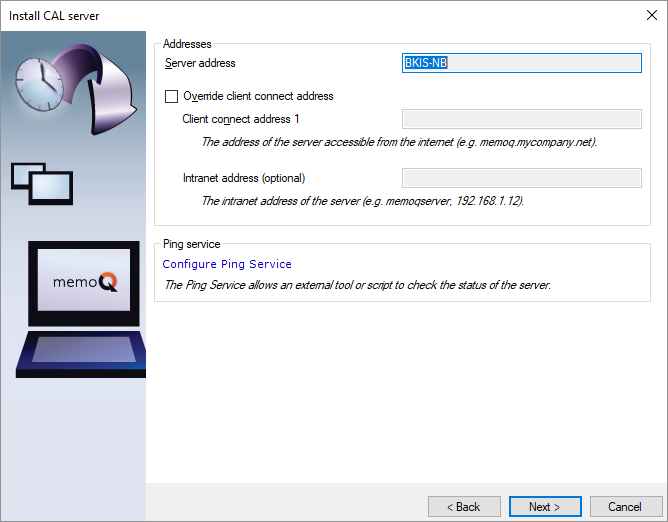
- Set the client connect address. This is the internet address or URL that memoQ clients will use to connect to your CAL server. Before choosing and configuring a client connect address, make sure that your server will be accessible by this address. To change the client connect address, check the Override client connect address check box. Type the client connect address in the Client connect address box.
- Click Next. The wizard is now ready to install CAL server:
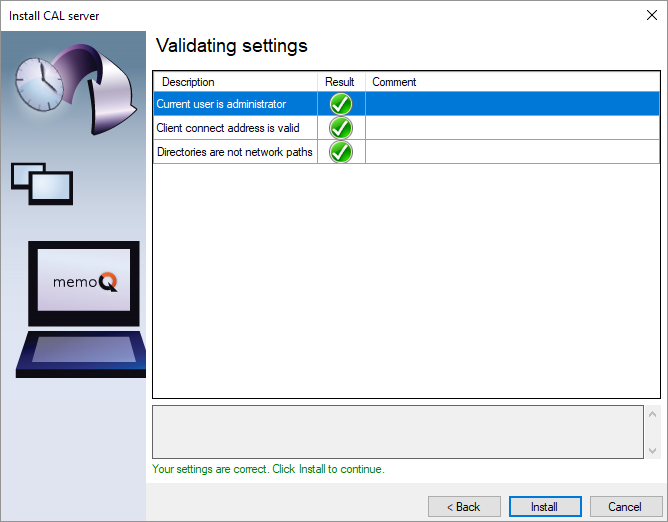
- If any of these checks fails (indicated by a red X), you will not be able to proceed with the installation. In this case, you will need to click Back, and review your settings.
- If all checks pass, click Install to proceed with the installation.
- The memoQ CAL server setup program installs your CAL server.
The next step is to start the CAL server. Normally, the CAL server service is automatically started when Windows starts. memoQ clients can receive their CAL licenses even if you do not log on to Windows on the server computer.
After you install CAL server, the memoQ CAL server manager program appears:
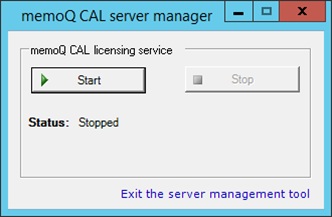
Click Start to start the CAL licensing service. When the service is started, the memoQ CAL server manager program looks like this:
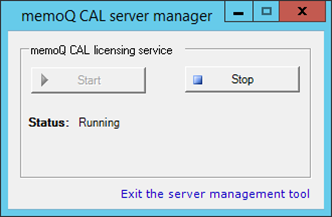
When the memoQ CAL server manager program is running, it displays a taskbar icon in the Windows notification area. The icon shows whether the CAL server is currently started or stopped. Look for an icon like this:
![]()
If you do not see any of these icons, the memoQ CAL server manager program is not started.
The green version of the icon indicates that the memoQ CAL server service is started. Red indicates that the service is stopped. Right-click the icon for a menu with the Start or Stop command.
- To start the memoQ CAL licensing service, right-click the taskbar icon. In the menu, choose Start.
- To stop the memoQ CAL licensing service, right-click the taskbar icon. In the menu, choose Stop.
- To close the memoQ CAL server manager, right-click the taskbar icon. In the menu, choose Exit.
Service runs on: The Exit command will not stop the memoQ CAL server service itself. The service will continue running, and the CAL licenses will remain available.
You can also start and stop the memoQ CAL server service in the Windows Services console. All Windows services can be managed from this single location.
To learn more about the Services console: Read this TechNet page.
If the memoQ CAL licensing service is not listed among Windows services, it is not installed. In that case, you need to install it from the memoQ server distribution package.
After you install and start the memoQ CAL licensing server, it is still “empty”: it does not know of any CAL license pools, and it cannot issue or revoke licenses.
To set up the actual licenses, you need the memoQ CAL license manager program that comes with memoQ (not memoQ server). To gain access to this program, install the memoQ desktop program (2014 or newer) on any computer that has a network connection to the CAL licensing server computer.
See also: For instructions to install memoQ, see the memoQ installation and activation guide in our Help Center.
- Click Start, or press the Windows key.
- In the Start menu, or the Start screen, type memoQ CAL.
- From the results, click memoQ CAL license manager.
When you start the memoQ CAL license manager tool for the first time, it will ask for the name (address or URL) of the server and the administrative password:
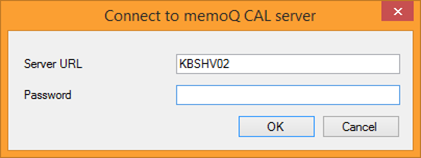
The initial password is pwadmin. After you set up the credential of the server, you should change this password.
After you connect to the CAL licensing server, the memoQ CAL license manager window opens:
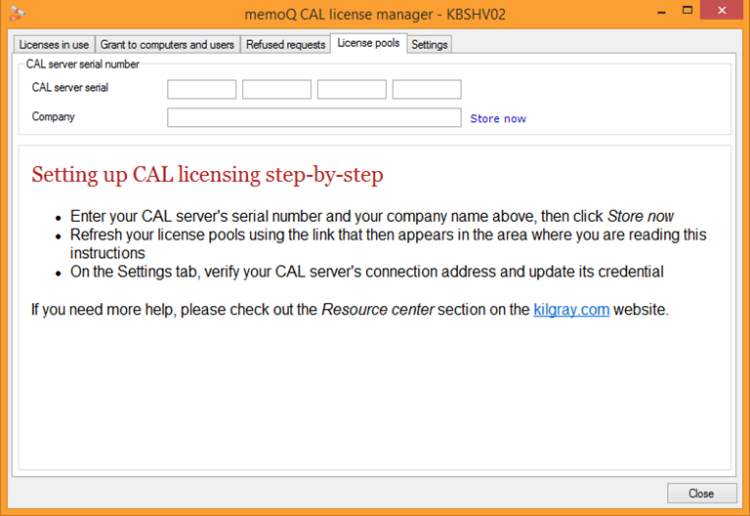
Enter the serial number of the CAL server in the CAL server serial boxes, and type the name of your organization in the Company box. Then click Store now.
The serial number of the server is the serial number that you received when you purchased the first CAL license pool from memoQ Zrt. You cannot start using the CAL licensing server if you have not acquired at least one CAL license pool.
Throughout your organization, you will be able to use memoQ with CAL licenses if you have a valid CAL license pool for this serial number, and the users or computers in the organization are granted permission to use licenses from the CAL license pool. To grant licenses to users and computers use the Grant to computers and users tab in this window.
After you store the serial number, you need to update the licenses on the CAL server, so that it knows about your CAL license pools. First, you need to update the credential of the CAL server. The credential is a secret code it uses to contact memoQ Zrt.'s activation server. After you click Store now, this screen appears:
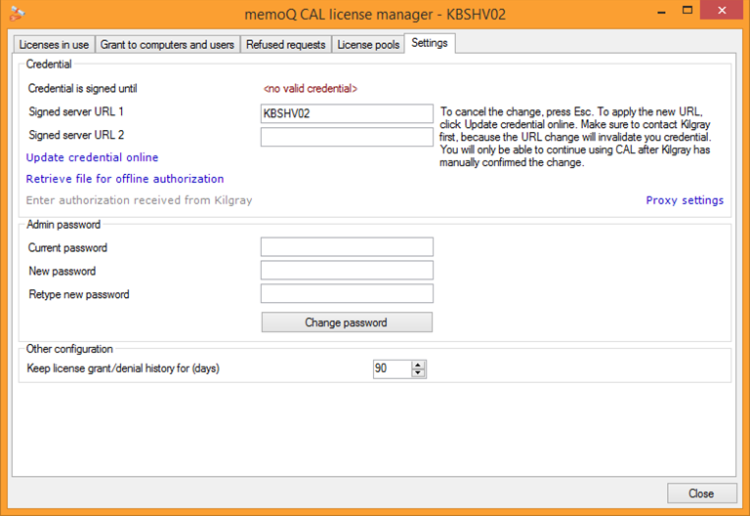
If the Settings tab does not appear automatically, click it.
In the Signed server URL 1 and the Signed server URL 2 boxes, enter the addresses by which the CAL server must be accessible. If your server has an internal and an external interface, it is recommended to use the external address in one of the boxes, and the internal one in the other. memoQ Zrt.'s activation server will authorize the CAL server to issue licenses if it is accessed by one of these addresses. After you enter the addresses, click Update credential online.
Troubleshooting: If this fails, click the Retrieve file for offline authorization link, and send the file to memoQ support with the request to authorize your CAL server.
Change password: You should change the initial password of the CAL server. You can do this in the lower part of the Settings tab: type the current password, twice the new password, and then click Change password.
After you set up the credential of the CAL licensing server, you can use the memoQ CAL server manager tool to update the license pools. You need to do this at the beginning, before you start issuing licenses through the CAL licensing server, and you also need to do this when your organization acquires additional licenses, or resigns existing ones.
In the memoQ CAL license manager tool, click the License pools tab:
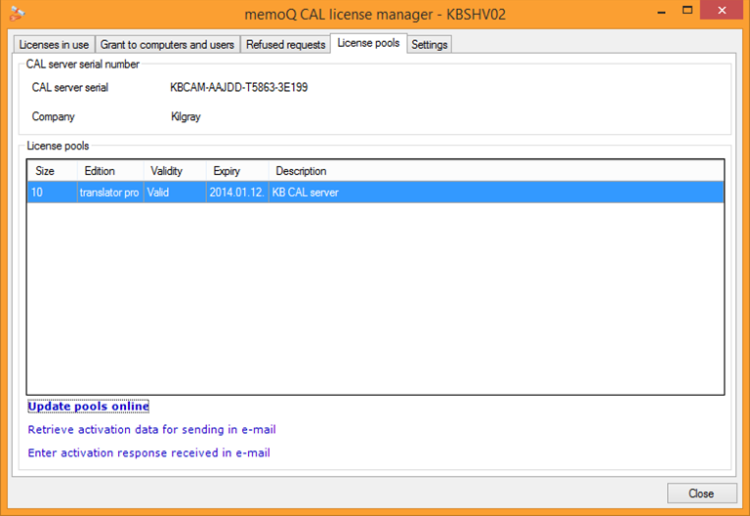
This tab shows the active license pools your server knows about. To update the license pools, click Update pools online.
If you acquire more than one license pools, they will appear separately on this tab. However, the CAL licensing server – and the memoQ CAL license manager tool – will treat them as one single license pool everywhere else. (Practically, you use two license pools, one for project manager licenses, and another for translator pro licenses.)
The CAL server does not recognize web licenses.
To grant permission to take licenses from the pool, click the Grant to computers and users tab:
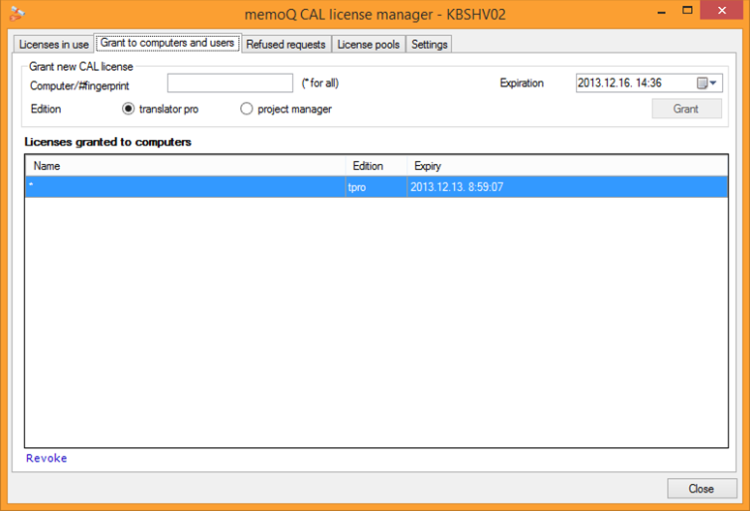
To grant permission to take licenses, type the computer name or its fingerprint in the Computer/#fingerprint box, set an expiry date and time, click the edition, and click Grant.
A fingerprint is a unique number that identifies a memoQ serial number. From the fingerprint, one cannot retrieve the serial number, and memoQ cannot be activated from a fingerprint. However, the CAL server can use it to identify the memoQ instance (practically, the user) using a license. To find the fingerprint of your serial number, open memoQ, and click the memoQ tab at the top. The fingerprint will appear in the top-right corner, next to the serial number of your copy.
To grant permission to all users who can access the memoQ program on a computer (this requires a valid logon to that computer, and permission to access the memoQ application), type an asterisk (*) in the Computer/#fingerprint box.
In most cases, you would grant licenses by the following logic:
- Grant permission to all computers to use translator pro licenses. Use the security and permission system to allow or deny users access to memoQ. (This is something that can be done using the group policy feature of Active Directory, for example – contact your organization's administrator to set this up.)
- Grant specific computers permission to use project manager licenses. This will properly restrict the use of project manager licenses to the computers where you want them to be used. The CAL server will give the highest edition that is authorized for the computer or user in question.
If you want to use project manager licenses in your organization, and you cannot determine the computers that will run the project manager copies, do the following: first, grant everyone a project manager license. Then log on in the name of the project managers (or ask them to log on), and start memoQ. In the memoQ CAL license manager window, look at the Licenses in use list (see the next section). That will give you the fingerprints of users who need the project manager edition. Take note of these fingerprints. Then revoke the project manager edition from all computers, and grant permission to these specific fingerprints only.
To revoke permission from a computer or a user, click the item in the Licenses granted… list, and click Revoke.
To view the licenses in use, click the Licenses in use tab in the memoQ CAL license manager tool. At the top, this tab shows the number of available project manager and translator pro licenses. Below that, a table shows all licenses currently in use, indicating the edition, the computer or user using the license, a fingerprint code that can be used for diagnostic purposes, and the time for which the license has been used.
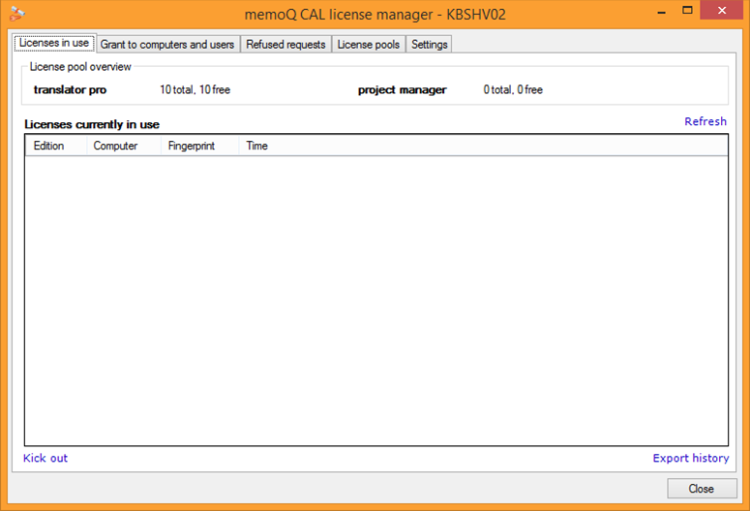
This view is not updated automatically. If you suspect that more or fewer licenses are being used than shown, click Refresh.
To take away a license from a memoQ client that uses one, select the license in the Licenses in use list, and then click Kick out.
To look at the licenses that were taken from and returned to the pool in the past, click Export history. To view or set how long the CAL licensing server keeps the history, click the Settings tab, and look at the Keep license grant/denial history for (days) box. You can also change the number of days there.
With CAL licenses, a license is freed up in the pool as soon as memoQ is closed by the user.
The memoQ CAL licensing server will refuse a license request if there are no remaining free licenses in the license pool, or the requesting computer or fingerprint was not granted permission to take the license. A request is also refused if the connection is lost in the process between memoQ and the CAL server. To view the list of refused requests, click the Refused requests tab in the memoQ CAL license manager tool.
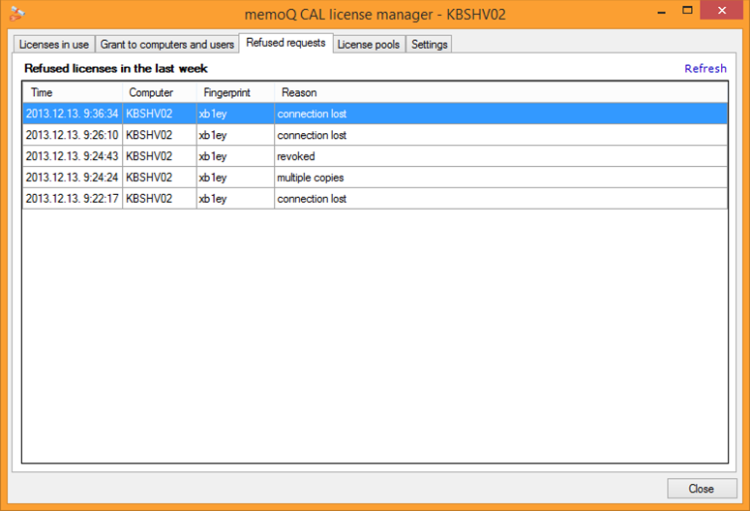
This tab gives you information about licensing problems. For example, it shows when a license is dropped because a computer does not have a reliable connection to the CAL server, or unauthorized, even malicious attempts to gain access to licenses.
This will help you troubleshoot licensing problems, and it will also give you hints to tighten security if rogue attempts are made to get licenses from the CAL server.
The list is not updated automatically; click Refresh to get the latest contents.
To use CAL licenses from memoQ: See Help about the memoQ Activation window.